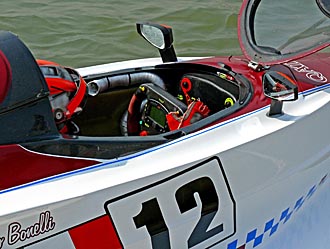 An F1 cockpit can look more like a Video game.
An F1 cockpit can look more like a Video game.
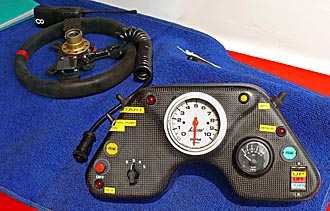 Thanks to the China team for setting their removable dashboard and steering wheel out for this photo! The wheel goes in after the driver!
Thanks to the China team for setting their removable dashboard and steering wheel out for this photo! The wheel goes in after the driver!
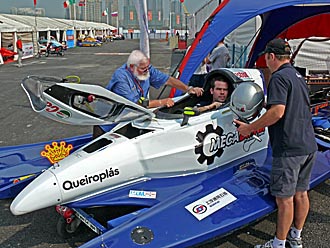 Every boat is thoroughly inspected before it's allowed in the water.
UIM Commissioner Ziggy Boettle's (L) eagle eye checks every detail of the boat and all safety equipment.
One of the teams told me, "We all call him Santa Claus. But he don't give us any presents!"
Every boat is thoroughly inspected before it's allowed in the water.
UIM Commissioner Ziggy Boettle's (L) eagle eye checks every detail of the boat and all safety equipment.
One of the teams told me, "We all call him Santa Claus. But he don't give us any presents!" 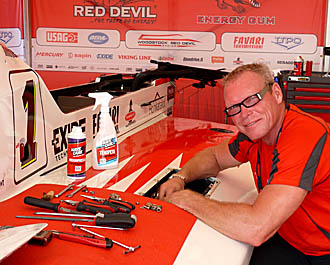 Sami Selio's crew prepares his boat. Sami won this year's Shenzhen F1 race, and he and his crew were real happy about it!
Sami Selio's crew prepares his boat. Sami won this year's Shenzhen F1 race, and he and his crew were real happy about it!
About F1 Boat Racing
Formula 1 Powerboat racing is the most spectacular water sport in the world. It has been described as driving an F1 race car at full speed over a ploughed field. Formula 1 Powerboats accelerate faster than even the most state-of-the-art F1 cars; they are capable of going from standstill to 160 kilometers per hour in only 4 seconds.
If you're really interested in the technical details, at last year's race I did several pieces for "boatdesign.net" which is a community of boat designers and builders. You can find them here (Click BACK to get back ..)Introduction: About F1 (CLICK)
Boats, Teams, Time Trials: (CLICK)
Race Day! (CLICK)
F1 racing uses tunnel hull catamarans that are capable of both high speed and exceptional maneuverability. Overall, the boats weigh 860 pounds (390 kilogram), including 260 pounds (118 kilograms) of engine. They are 20 feet (6 meters) long and seven feet (2 meters) wide, keeping weight low through extensive use of carbon fiber and kevlar. The tunnel hull design creates an air cushion under the hull, so that at speed only a few inches touch the water, leading to the high speed possible with these hulls.(From WikiPedia: search "F1 Powerboat Racing")
These boats look more like aircraft than boats, and indeed are flying on air down the straightaways.
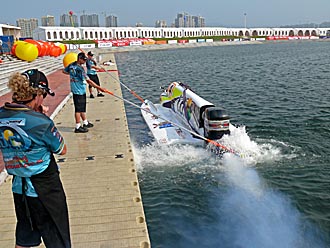 Trask team tests their engine with a "Load Disc" in place of the propeller. This gives almost the same load VS RPM of a propeller,
and allows something close to dynamometer testing.
Calibration runs are done with the crew chief sitting in the cockpit with his laptop computer hooked up to the boat.
Trask team tests their engine with a "Load Disc" in place of the propeller. This gives almost the same load VS RPM of a propeller,
and allows something close to dynamometer testing.
Calibration runs are done with the crew chief sitting in the cockpit with his laptop computer hooked up to the boat.
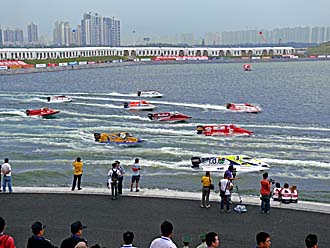 The green flag waves to start practice laps. This is the first time boats actually move in the lake.
The green flag waves to start practice laps. This is the first time boats actually move in the lake.
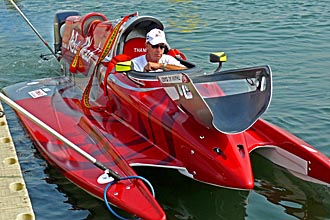 I talked about engine details with Ron Anderson, the legendary designer at Mercury who conceived and pushed this V6 design over 30 years ago.
Here Ron, who works for the Abu Dhabi team, is tuning an engine with a "load disk" in place of a propeller.
I talked about engine details with Ron Anderson, the legendary designer at Mercury who conceived and pushed this V6 design over 30 years ago.
Here Ron, who works for the Abu Dhabi team, is tuning an engine with a "load disk" in place of a propeller.
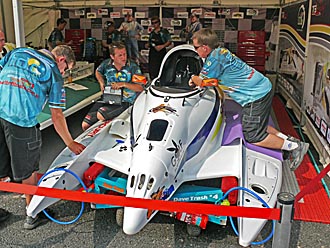 The Trask Brothers team prepares a boat for racing.
The Trask Brothers team prepares a boat for racing.
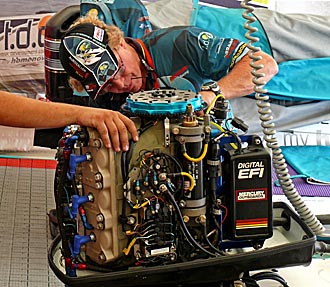 Here they do last-minute checks on a Merc V6 of almost 400 HP.
Here they do last-minute checks on a Merc V6 of almost 400 HP.
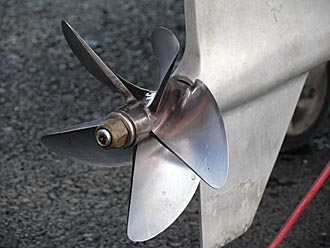 The lower units have no clutch or reverse: you start the engine and you GO! The propellers run with their tops above the surface of the water.
There is so little water drag that 5 seconds after a boat goes by at 100 MPH, there is no wake to be seen.
The lower units have no clutch or reverse: you start the engine and you GO! The propellers run with their tops above the surface of the water.
There is so little water drag that 5 seconds after a boat goes by at 100 MPH, there is no wake to be seen. 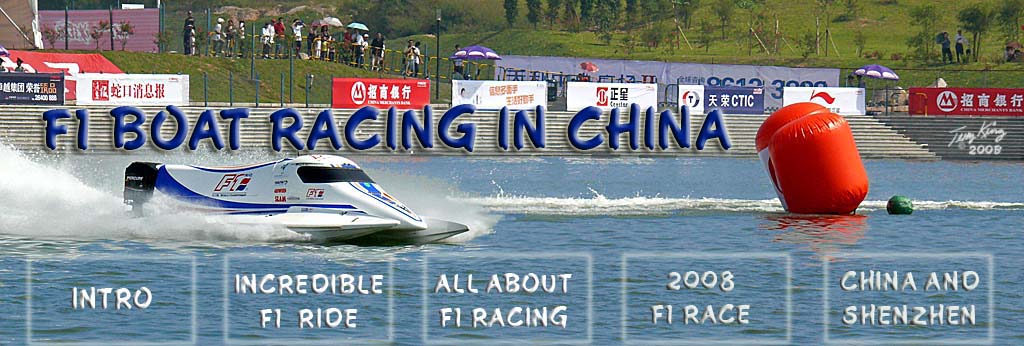

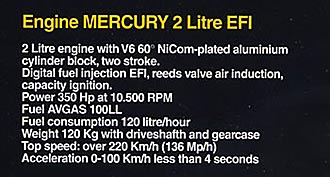 (Photo Credits: F1boat.com)
(Photo Credits: F1boat.com)
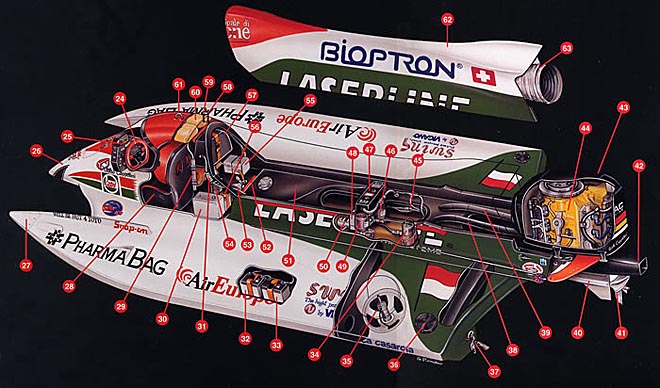
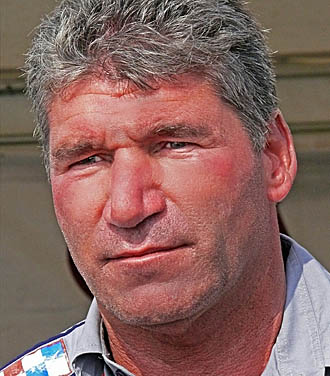 Jay Price is a big, rugged guy from Louisiana in the USA, where he's had hurricanes to contend with the last few years.
He is in the lead for the F1 World Championship for 2008.
Jay Price is a big, rugged guy from Louisiana in the USA, where he's had hurricanes to contend with the last few years.
He is in the lead for the F1 World Championship for 2008.
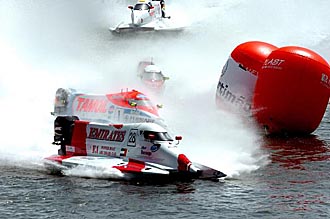 TRAFFIC - inches away at 100 MPH
TRAFFIC - inches away at 100 MPH
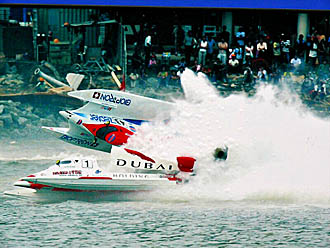 Can lead to THIS! Guido Cappellini crashes. Traffic can be WICKED, like this
Can lead to THIS! Guido Cappellini crashes. Traffic can be WICKED, like this 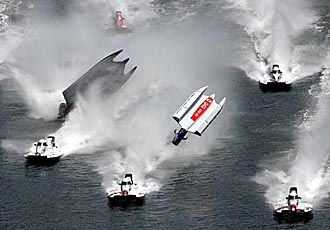 At an aerodynamic 100 MPH, a gust of wind, or wakes of other boats can cause the dreaded airborne BLOWOVER!
Like this
At an aerodynamic 100 MPH, a gust of wind, or wakes of other boats can cause the dreaded airborne BLOWOVER!
Like this 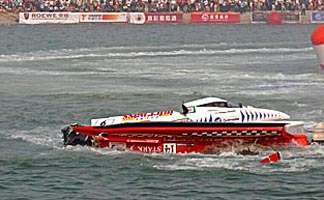 Here's what it looked like to me, just as the spray fell, and the water still boiled around the boats.
Here's what it looked like to me, just as the spray fell, and the water still boiled around the boats.
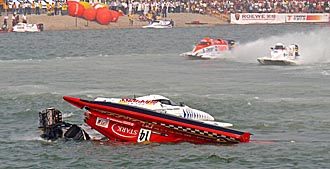 About 5 seconds later: notice that Jonas Andersson's boat (red) is no longer level upside down because his safety airbag has started to deploy. Automatic vents also quickly sink the stern.
About 5 seconds later: notice that Jonas Andersson's boat (red) is no longer level upside down because his safety airbag has started to deploy. Automatic vents also quickly sink the stern. 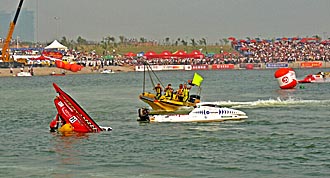 Now you can see the yellow airbag, as the Osprey Rescue guys roar in from the inside of the course.
Jonas's head is now above water and he's opening the canopy.
Now you can see the yellow airbag, as the Osprey Rescue guys roar in from the inside of the course.
Jonas's head is now above water and he's opening the canopy. 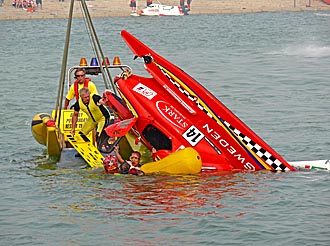 2 rescue divers help Jonas Andersson from his boat. The overall boat buoyancy and the sunken stern have positioned the cockpit just clear of the waterline.
2 rescue divers help Jonas Andersson from his boat. The overall boat buoyancy and the sunken stern have positioned the cockpit just clear of the waterline.
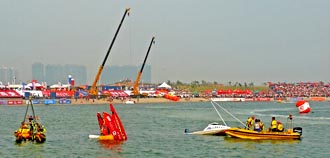 Both drivers have been recovered by the two Rescue Teams.
Both drivers have been recovered by the two Rescue Teams.
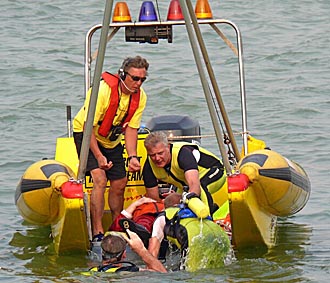 The Rescue boat has a drop-front like a landing craft, and an injured driver can be slid gently into the boat on a stretcher.
No more pulling someone over the gunwale.
The Rescue boat has a drop-front like a landing craft, and an injured driver can be slid gently into the boat on a stretcher.
No more pulling someone over the gunwale.
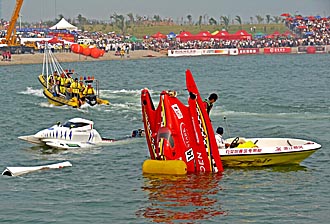 Both Rescue boats head for shore to the Emergency Medical crews. Tow boats arrive to bring the boats in.
Both Rescue boats head for shore to the Emergency Medical crews. Tow boats arrive to bring the boats in.
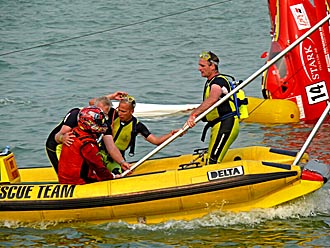 He's up and off the Stretcher, as they check him out. He was not seriously injured.
He's up and off the Stretcher, as they check him out. He was not seriously injured.
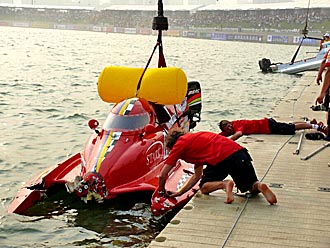 The recovered Andersson boat. The collapsible nose and pickle forks have done their job. So has the airbag system.
The recovered Andersson boat. The collapsible nose and pickle forks have done their job. So has the airbag system.